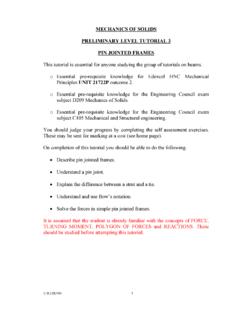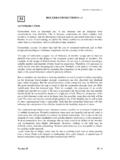Transcription of Chapter 1 Structural Mechanics - uacg.bg
1 - 1 - F F Chapter 1 Structural Mechanics Introduction There are many different types of structures all around us. Each structure has a specific purpose or function. Some structures are simple, while others are complex; however there are two basic principles of composing structures. They must be capable of carrying the loads that they are designed for without collapsing. They must support the various parts of the external load in the correct relative position. A structure refers to a system with connected parts used to support a load.
2 Some examples related to civil engineering are buildings, bridges and towers. However, these structures are very complex for analyze and design. At first, we will consider simple examples of structures and parts of structures like beams, trusses, frames etc. It is important for a Structural engineer to recognize the various type of elements composing a structures and to be able to classify them as to there form and function. We will introduce some of these aspects. Structural elements: Some of most common Structural elements are as follow: Tie rods Structural members subjected to a tensile force .
3 Due to the nature of the load, these elements are rather slender and are often chosen from rods, bars, angels, or channels. beams straight horizontal members are used generally to carry vertical loads. Beams may be designed from several of element and materials concrete, metal etc. with rectangular or other cross section. columns members are generally vertical and resist axial compressive loads. Columns are elements similar to the tie rods but they carry vertical loads. F F rod bar angle channel F F - 2 - Type of structures 1.
4 Frame structures: trusses, three-hinged frame, frames, trusses: they are composed of slender rods usually arrenged trintriangular fashion. Trusses are suitible for constructions with large span when the depth is not an important criterion for desing. Plane trusses are composed of members that lie in the same plane and are frequantly used for bridge and roof support. three-hinged frame: this structure is simple determinate frame used generally for base element for complicated frame structures. frames: they are often used in buildings and are composed of beams and columns which are with hinge or rigid connections.
5 These structures are usually indeterminate and the load causes generally bending of its members. plane structures: plates, walls and etc. These structures have two significant dimensions and one small called thickness. The theory of elasticity is capable to analyze such structures. - 3 - surface structures: shells and etc. These structures can be made from flexible or rigid material and has a three-dimensional shape like a cylinder hyperbolic paraboloid etc. The analysis of these structures is also aim of theory of elasticity.
6 Loads: In statical Structural analysis of frame structures we define statical (dead) load. We distinguish types of loads: force load: concentrated force or moment, distributed load. temperature load: load caused by fire. thickness thickness F M concentrated force concentrated moment distributed load Point N q q1 q2 ( )xf - 4 - displacement load: load displacement is caused from displacement of some point or points of the structure. Idealized structures: Idealized structure is needed to the engineer to perform a practical force analysis of the whole frame and its member.
7 This is the reason in this section to show different member connections and supports and there idealizations. If one know these models may compose idealized model of each real structure after all perform the analysis and design. rigid (fixed) connections: this connection carry moment, shear and axial forces between different members. In addition, in this case all members including in such a connection have one and the same rotation and displacements the nodal rotation and displacements. Typical rigid connections between members in metal and in reinforced concrete constructions and there idealized models are shown in the following figure: hinged (pin) connections: this connection carry shear and axial forces but not moment between different members.
8 Hinged connection allow to the jointed members to have different rotations but the same displacements. T ypical hinged connections between members in metal and in reinforced concrete constructions and there idealized models are shown in the next figure: I2 I1 Rigid connection, I1 =I2 - 5 - fixed support: this support carry moment, shear and axial forces between different members. This kind of support doesn t allow any displacements of the support point. So if the displacement along the x axis is u, the displacement along y axis is y and the rotation is called then we can say that: uA = 0; vA = 0 and A = 0.
9 Hinged (pin) support: this support carry shear and axial forces but not moment between different members. The hinged support allows rotation of the support point but the two displacement are equal zero or: uA = 0; vA = 0 and A 0. AyAxAAMxyyAxAAMS upport reactions Idealization of the support and support reactions hinged connection, I2 <<I1 I2 I1 AAyAyAxAxAxyxAyA yA xA yA xASupport reactions Idealization of the support and support reactions - 6 - roller support: this support carry only shear forces between jointed members.
10 The roller support allows rotation and one displacement of the support point: uA 0; vA = 0 and A 0. spring supports: These supports are like the previous but with the difference that they are not ideally rigid but with some real stiffness. The spring has a stiffness constant c equals to the force caused by displacement d = 1. structure idealization: The main idea of this idealization is to made a mathematical model of the real construction to be convenient for analysis and calculation. After we know the idealization of different joints and supports, we will take care about whole structure idealization.










